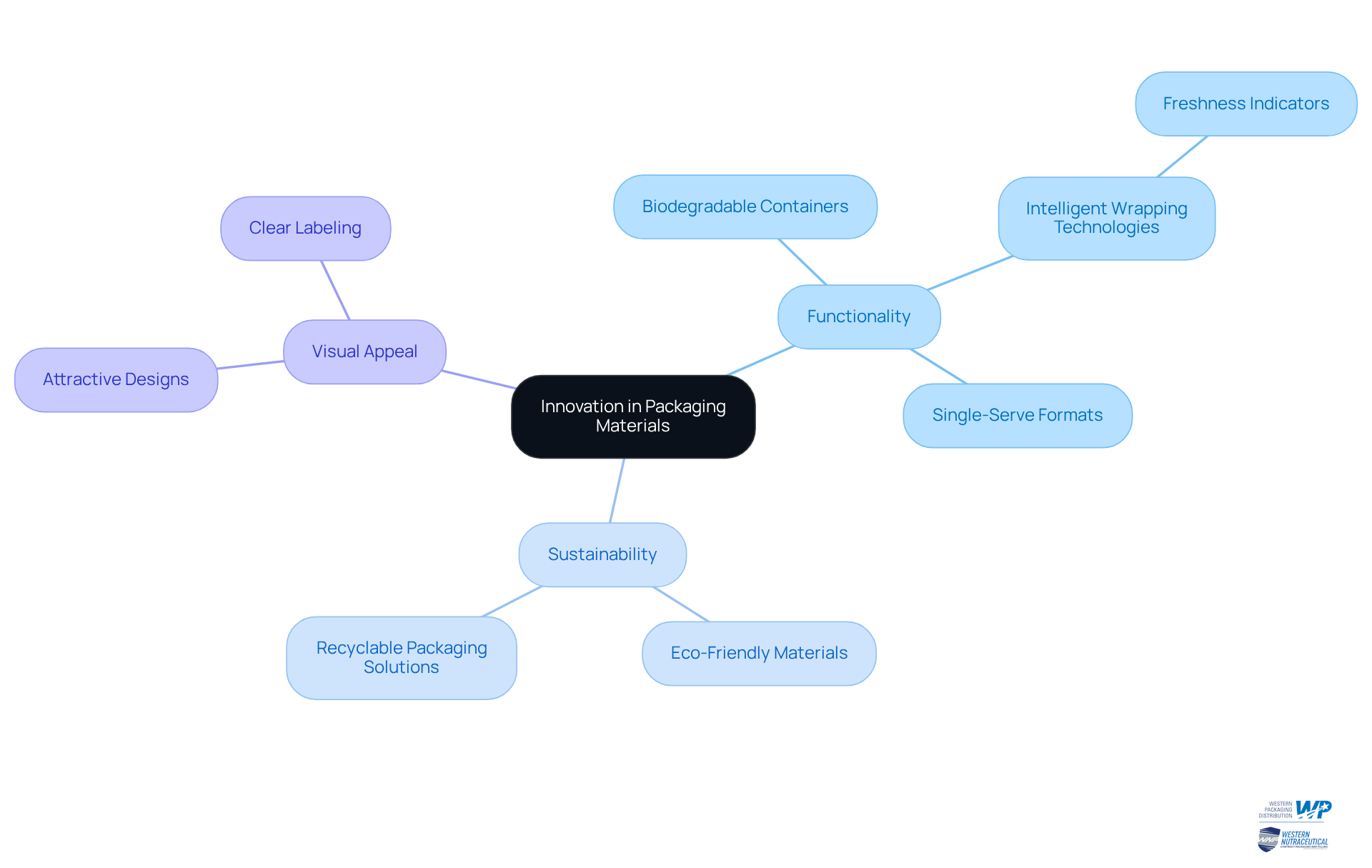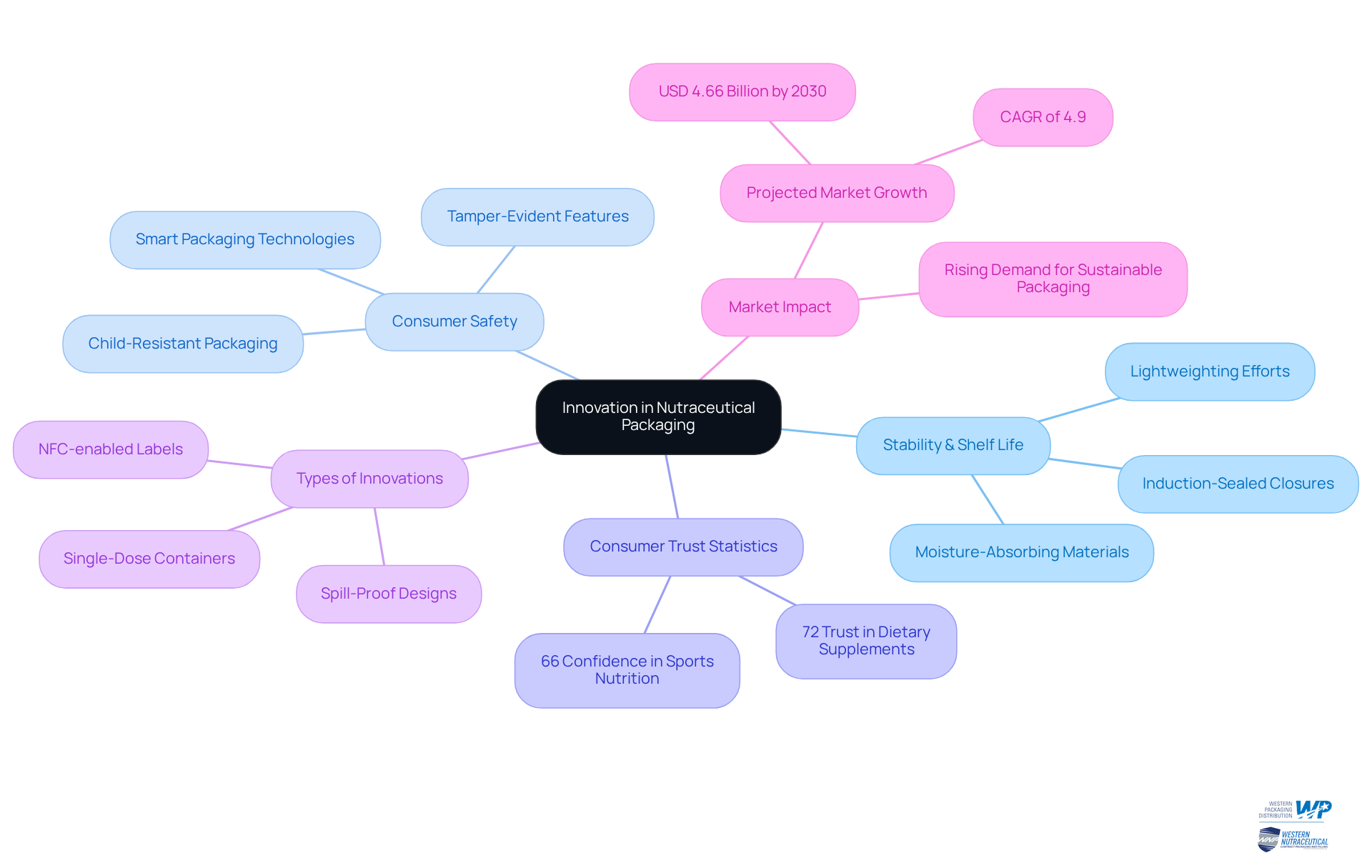Overview
This article delves into the pivotal role of innovation in packaging materials for nutraceuticals, underscoring its significance in enhancing product functionality, sustainability, and consumer appeal. By examining advancements such as:
- Biodegradable materials
- Intelligent packaging features
- The growing consumer preference for eco-friendly options
it illustrates how these innovations not only meet market demands but also bolster product integrity. This exploration provides a comprehensive understanding of how the packaging industry is evolving to align with consumer values and environmental considerations.
Introduction
Innovation in packaging materials is revolutionizing industries, particularly the nutraceutical sector, where effective packaging can greatly enhance product appeal and consumer trust. As sustainability increasingly becomes a priority for consumers, the demand for advanced packaging solutions—such as biodegradable containers and smart labels—continues to rise.
However, amidst this significant shift, nutraceutical companies face the challenge of balancing innovation with cost-effectiveness, all while ensuring product integrity and safety.
How can they navigate this complex landscape? The answer lies in strategic investment in packaging technologies that not only meet consumer demands but also uphold the highest standards of quality and reliability.
Define Innovation in Packaging Materials
Innovation in packaging materials encompasses the development and application of advanced substances and technologies that significantly enhance functionality, sustainability, and visual appeal. This innovation in packaging materials is particularly vital in the nutraceutical industry, as it not only safeguards product integrity but also elevates customer attraction and communicates brand values effectively.
Noteworthy examples include:
- Biodegradable container solutions that align with escalating environmental concerns
- Intelligent wrapping technologies featuring freshness indicators that ensure product quality
- The transition towards single-serve formats exemplifies designs that prioritize convenience and user-friendliness
Recent statistics reveal that a substantial segment of consumers now prefers products with eco-friendly wrappers, highlighting a broader trend towards environmentally conscious purchasing decisions. This growing demand underscores the necessity for nutraceutical companies to adopt innovative solutions, such as innovation in packaging materials, that not only meet regulatory standards but also resonate with health-conscious consumers who seek both efficacy and environmental responsibility.

Explore the Evolution of Packaging Materials
The development of wrapping materials has its origins in ancient civilizations, where natural substances such as leaves and animal skins served as primary coverings. The introduction of glass and metal containers represented significant advancements, enabling better preservation of products. The 20th century witnessed a transformation in the industry with the advent of plastics, which offered lightweight, durable, and versatile options. In contemporary times, the focus has shifted towards sustainable resources, with innovation in packaging materials like bioplastics and recyclable containers gaining considerable traction. Furthermore, the rise of e-commerce has influenced container design, leading to the creation of protective and efficient shipping solutions. This historical perspective underscores the continuous effort to enhance container materials in response to evolving consumer demands and ecological challenges.

Identify Key Characteristics of Innovative Packaging
Key traits of innovative containers in the nutraceutical sector include the innovation in packaging materials, which encompasses sustainability, functionality, and customer engagement. As environmental consciousness grows, the innovation in packaging materials such as biodegradable plastics and recycled content has become crucial. Notably, 71% of global shoppers actively consider recyclability when selecting items for purchase. Furthermore, 82% of shoppers worldwide are willing to pay extra for products that utilize sustainable materials, underscoring the economic impact of adopting eco-friendly alternatives.
Functionality is equally significant, incorporating features like resealable closures, portion control, and tamper-evident designs that reflect innovation in packaging materials, enhancing user experience and ensuring safety. Additionally, customer involvement is encouraged through interactive wrappers, such as QR codes that provide detailed product information or promotional content.
These traits not only enhance the functionality of containers but also bolster brand loyalty by aligning with consumer values and preferences, highlighting the importance of innovation in packaging materials, as 58% of individuals express a preference for brands committed to sustainability. However, it is important to note that 39% of individuals identify higher costs as a barrier to purchasing sustainably packaged items. This highlights the necessity for clear labeling and communication regarding sustainability initiatives to foster trust.

The Impact of Innovation on Nutraceutical Packaging
The innovation in packaging materials plays a crucial role in the nutraceutical sector, effectively addressing challenges related to stability, shelf life, and consumer safety. For example, moisture-absorbing substances are increasingly utilized to prevent the degradation of sensitive components, ensuring that products maintain their efficacy over time. Notably, statistics reveal that 72% of Americans trust dietary supplements, underscoring the importance of packaging that guarantees safety and quality.
Furthermore, the innovation in packaging materials, such as NFC-enabled labels, provides real-time information regarding product freshness, thereby enhancing consumer confidence. Recent advancements in packaging design, including single-dose containers and spill-proof designs, respond to the growing demand for convenient health solutions.
By adopting innovation in packaging materials, nutraceutical brands can markedly improve product quality, elevate market appeal, and ultimately drive sales and foster customer loyalty.

Conclusion
Innovation in packaging materials is paramount for the nutraceutical industry, significantly enhancing not only the functionality and sustainability of products but also the overall consumer experience. By adopting advanced materials and technologies, companies can effectively safeguard product integrity while appealing to health-conscious consumers who prioritize both efficacy and environmental responsibility.
Key insights throughout the article underscore the evolution of packaging from ancient materials to modern, sustainable solutions. The discussion encompasses the vital role of biodegradable options, intelligent wrapping technologies, and user-friendly designs that cater to contemporary consumer preferences. Furthermore, the importance of transparency and communication regarding sustainability initiatives is highlighted, as these factors profoundly influence purchasing decisions and foster brand loyalty.
The significance of innovation in packaging transcends mere aesthetics; it directly impacts product quality, consumer trust, and market competitiveness. As the demand for eco-friendly and functional packaging continues to escalate, nutraceutical brands must wholeheartedly embrace these innovations to thrive in an increasingly conscious marketplace. Engaging in sustainable practices not only meets consumer expectations but also positions brands as leaders in the industry, paving the way for a healthier future for both people and the planet.
Frequently Asked Questions
What is meant by innovation in packaging materials?
Innovation in packaging materials refers to the development and application of advanced substances and technologies that enhance functionality, sustainability, and visual appeal in packaging.
Why is innovation in packaging materials important for the nutraceutical industry?
It is crucial for the nutraceutical industry as it safeguards product integrity, elevates customer attraction, and effectively communicates brand values.
What are some examples of innovative packaging materials?
Examples include biodegradable container solutions, intelligent wrapping technologies with freshness indicators, and single-serve formats designed for convenience and user-friendliness.
What trend is observed among consumers regarding packaging?
A significant segment of consumers now prefers products with eco-friendly wrappers, indicating a trend towards environmentally conscious purchasing decisions.
What does the growing demand for innovative packaging solutions imply for nutraceutical companies?
It implies that nutraceutical companies need to adopt innovative packaging solutions that meet regulatory standards and appeal to health-conscious consumers seeking efficacy and environmental responsibility.




